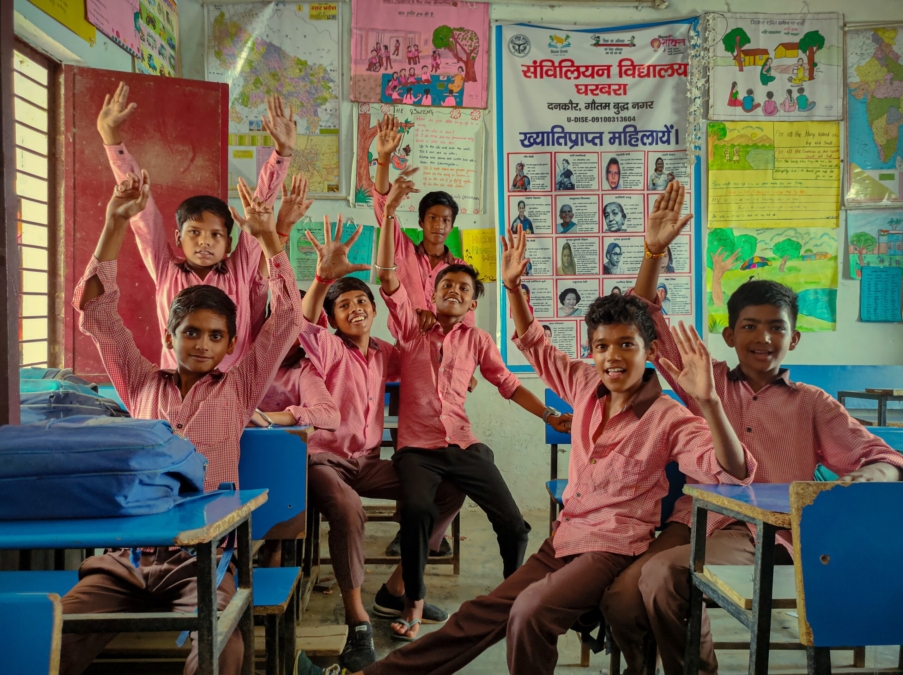Exploring the current scenario of Environmental Education and its Barriers
The highest education is that which does not merely give us information but makes our life in harmony with all existence – Rabindranath Tagore. This one sentence covers the aim of environmental education and what it intends to achieve. Environmental education is not just about learning facts and figures about the environment, but also about developing a deep understanding of our interconnectedness with nature. It aims to inspire individuals to take action towards creating a sustainable future for all living beings on our planet.
Ted Turner, founder and chairman of the United Nations Foundation states, “Education is a foundation for sustainable development. Educating the next generation of leaders about the importance of protecting our environment and combating climate change is a key investment for a sustainable planet and future for us all” [3]. Education can motivate people to take action to lessen their impact on the environment by raising awareness and concern, such as by using water and energy more wisely. As people in high-income countries are urged to alter their consumption and take other actions to reduce environmental harm, such behaviour becomes more and more crucial. According to a study of households across 10 OECD nations, households with higher levels of education tend to conserve water [3]. The Sustainable Development Goals (SDGs) have further highlighted the need for proper and resourceful environmental education to reach the desired goals of a nation and globally.
In 2019 India was ranked seventh most affected nation by climate change, yet 65% of the Indian population had not heard of climate change [2]. Therefore, raising awareness about climate change is crucial to ensure that individuals and communities, in India, take necessary actions to mitigate its impact. It is imperative for governments, NGOs, and individuals to work together towards creating a sustainable future for our planet.
Environmental Education in India
Given the biodiversity and natural resources of India, environmental education is a crucial component. The primary government agency in charge of environmental education in India is the Ministry of Environment, Forest, and Climate Change (MoEF&CC). Environmental education has been identified as a crucial part of the school curriculum in the National Curriculum Framework (NCF) created by the National Council of Educational Research and Training (NCERT). In 2003, Environmental education was made compulsory in formal education in India through a Supreme Court ruling.
India’s first 21st-century education policy, the National Education Policy (NEP), was unveiled in 2020. The NEP is introduced with a perspective on Education for Sustainable Development. If India wishes to meet the established goals and targets, NEP has given special focus to the need to structure the nation’s overall educational system [1]. People with higher levels of education typically have greater environmental concerns and participate in activism that supports and promotes governmental actions that protect the environment. Such pressure is an essential tool for influencing governments to reach the kind of legally binding agreement required to regulate emission levels [3]. This aspect further strengthens the need for a structured and evolving environment education system in India.
Another notable effort by the Indian government to promote environmental education is the National Green Corps (NGC) program. Its main objective is to educate school children about environmental issues and provide them with resources for learning about conservation and sustainable development. The NGC program gives pupils the chance to develop into environmentally aware individuals and motivates them to take action for the preservation of natural resources [6].
Access to Environmental Education – Mission LiFE
Environmental education has been made accessible to citizens with access to education through the years, as it has been made mandatory at school levels and there has been a rise in environment-related courses and specialisations at both undergraduate and postgraduate levels [4]. On the other hand, there are a considerable number of people in the country, other than the present youth who do not have access to quality education and thus remain unaware of the climate emergency the world is currently facing. It is in such scenarios that government initiatives and NGO awareness campaigns play an essential role.
One such government initiative is the ‘Mission LiFE’ that was launched at the 2021 UN Climate Change Conference (UNFCCC COP26). LiFE intends to use the power of social networks to change societal attitudes around climate [7]. ‘Pro-Planet People’, abbreviated as P3, a global network of people with a shared commitment to adopting and promoting ecologically sustainable lifestyles, is what the Mission hopes to establish and develop. The Mission aims to establish an ecosystem through the P3 community that will support and enable environmentally responsible behaviour to become self-sustaining [7].
Its goal is to inspire at least 1 billion Indians and other global citizens to take both individual and group action to preserve and conserve the environment between 2022 and 2028. By 2028, India’s villages and urban local governments must at least be 80% environmentally friendly [8]. The mission aims to target all aspects of sustainable living like water efficiency, waste management, energy efficiency, etc. Citizens are made aware of actions that they can take and encouraged to follow sustainable practices.
Barriers to Environmental Education in India
Even though there has been a good change in the environmental education realm of India, there are certain barriers that prevent it from reaching its optimum. As discussed above, the lack of awareness and thus lack of community participation has been a major aspect and there have been steps, LiFE for example, that have been set up to deal with the issue.
One major barrier that exists is the curriculum provided to students. The current curriculum focuses primarily on information like environmental regulations, wildlife conservation, and Supreme Court rulings [5]. These topics, though required, are not the most important. Climate change and its related aspects, which change with each year passing, hold more substance and importance when it comes to environmental education. These topics can only be further enhanced with practical knowledge. Environmental issues that students encounter daily need to be covered in the course syllabus which then, should be related to complicated global environmental issues [5]. Students will then be inspired to come up with answers once they realise how directly connected environmental challenges are to their lives and future. It will cause them to modify how they act, and this should be the ultimate aim of environmental education. Lack of organisational support is also a barrier. Every stakeholder in society has individual obligations to fulfil as well as a duty to provide an equal contribution to society’s education [9]. One may always find time for different environmentalists or organisations working on environmental issues to share their insights and contributions. They might also provide funding to educational institutions to set up workshops for instructors and students on environmental awareness [9]. This would be an encouragement for individuals to attend new-age workshops and webinars to be more aware of the environmental concerns of the world.
Empowering Minds, Transforming Futures
The link between sustainable development and education is not immediately clear. The nature of it is intricate. The status and level of education within the country will determine its ability to meet the Sustainable Development Goals and targets. It is a fundamental requirement that everyone must understand. The objectives set would only be a vision without this [1]. Though on the right track, India still has some distance to go in establishing an all-encompassing environment education system. Along with spreading awareness, networking and partnerships with organisations and individuals within the sustainable field will help take the education standard to greater heights.
If you are interested in learning and discovering more related to our environment, look no further! Connect with us to gain invaluable insights on various aspects of the environment and sustainability practices. Our carefully curated training sessions and materials along with our experts can help you in being environmentally educated.
List of References
- Choudhary, S. K. (2022). EDUCATION FOR SUSTAINABLE DEVELOPMENT IN INDIA: A NARRATIVE REVIEW. https://kalaharijournals.com/resources/Spe2%20Jan_Feb_11.pdf. Accessed 22nd, May 2023
- Jones, V., Mitra, S., & Gupta, N. (2022, December 14). Climate change and sustainability education in India and the place for Arts-based practice: Reflections from East Kolkata Wetlands. ScienceOpen. https://uclpress.scienceopen.com/hosted-document?doi=10.14324%2FLRE.20.1.48. Accessed 22nd May, 2023
- Sustainable development begins with education. https://sdgs.un.org/sites/default/files/publications/2275sdbeginswitheducation.pdf. Accessed 9th June, 2023
- Environmental education in India – UPSC. LotusArise. https://lotusarise.com/environmental-education-in-india-upsc/#:~:text=The%20Ministry%20of%20Environment%20and,the%20environment%20and%20improve%20it. Accessed 17th June, 2023
- Foundation, T. R. It’s time to reform India’s environmental education. https://news.trust.org/item/20210713142406-0ls4y. Accessed 20th June 2023
- National Green Corps. (2022). https://en.wikipedia.org/wiki/National_Green_Corps. Accessed 20th June 2023
- Life. https://www.niti.gov.in/life. Accessed 29th June 2023
- An India-led global mass movement to Nudge – Niti Aayog. https://www.niti.gov.in/sites/default/files/2022-10/Brochure-10-pages-op-2-print-file-20102022.pdf. Accessed 29th June 2023
- Sherpa K (February, 2022). CHALLENGES OF ENVIRONMENTAL EDUCATION IN THE CONTEXT OF INDIAN EDUCATION SYSTEM. https://www.ijcrt.org/papers/IJCRT2202009.pdf. Accessed 27th July 2023

